Southern Cross (aircraft)
| Southern Cross | |
|---|---|
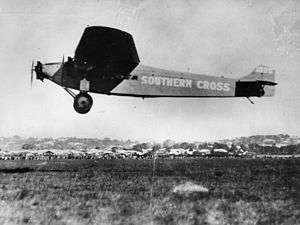 | |
| Southern Cross landing in Brisbane, 1928 | |
| Type | F.VIIb/3m |
| Manufacturer | Fokker |
| Registration |
|
| Owners and operators |
|
| Preserved at | The Kingsford Smith Memorial near Brisbane Airport |
Southern Cross is the name of the Fokker F.VIIb/3m trimotor monoplane that in 1928 was flown by Australian aviator Charles Kingsford Smith, Charles Ulm, Harry Lyon and James Warner in the first-ever trans-Pacific flight to Australia from the mainland United States, a distance of about 11,670 kilometres (7,250 mi).
History
The Southern Cross began life as the Detroiter, a polar exploration aircraft of the Detroit News-Wilkins Arctic expedition.[1] The aircraft had crashed in Alaska in 1926, and was recovered and repaired by the Australian expedition leader, Hubert Wilkins. Wilkins, who had decided the Fokker was too large for his Arctic explorations, met with Kingsford Smith and Charles Ulm in San Francisco and arranged to sell them the aircraft, without engines or instruments.[2]
Having fitted the aircraft with engines and other required parts, Kingsford Smith made two attempts at the world endurance record in an attempt to raise funds and interest for his trans-Pacific flight. However, after the New South Wales government withdrew its sponsorship of the flight,[3] it looked as if the money would run out and Kingsford Smith would have to sell the Southern Cross. The aircraft was bought by American aviator and philanthropist Allan Hancock, who then loaned it back to Kingsford Smith and Ulm.[4]

Trans-Pacific flight
On 31 May 1928, the crew—Charles Kingsford Smith, Charles Ulm, and Americans Harry Lyon (navigator) and James Warner (radio operator)[3]—took off from Oakland, California, United States. The Southern Cross first stopped for rest and refuelling in Hawaii before setting off for Fiji. This leg of the journey took 34 1⁄2 hours of flight across open seas before gliding past the Grand Pacific Hotel in Suva, where a large and enthusiastic crowd saw the first aircraft to land in Fiji touch down at Albert Park.[5] The Southern Cross landed at Eagle Farm Airport in Brisbane, Queensland, Australia, on 9 June,[6][7] where a crowd of 25,000 people were waiting to greet the Southern Cross on its arrival at the airport.[8][9][10] The Southern Cross flew on to Sydney the following day (10 June).
The aircraft was in constant radio communication with ships and shore during the flight using four transmitters and three receivers powered by a propeller-driven generator attached to the fuselage below the cockpit.[11] Transmitters included one 50 watt short-wave set operating at 33.5 meters wavelength and two 60 watt sets operating at 600 meters, with one 600 meter emergency waterproof set capable of operating eight hours submerged.[11] Receivers, sharing a common audio amplifier, included a short-wave, long-wave and beacon.[11] The first paid commercial messages were sent and received during the flight and a new world record distance for radio was set with a short-wave reception at Bloemfontein, South Africa, the long way around the world at 12,800 miles (20,599.6 km).[11] Direct short-wave aircraft-to-shore communications were maintained with the Pacific Coast until the flight was four hours out of Honolulu which had been monitoring the flight from two hours after departure with a similar reception overlap on the Honolulu to Suva leg.[11] Success on this flight influenced Admiral Byrd to equip his three Antarctic Expedition aircraft with similar equipment.[11]
Trans-Tasman flights
.jpg)
Kingsford Smith, Ulm, and Sir Gordon Taylor also made the first nonstop Trans-Tasman flight in the Southern Cross – over the Tasman Sea from Australia to New Zealand – beginning with the first crossing on 10–11 September 1928, a distance of 2,670 kilometres (1,660 mi).[12] They then flew back to Australia.
Guy Menzies completed the first solo trans-Tasman flight in the Southern Cross Junior in 1931.
Preservation
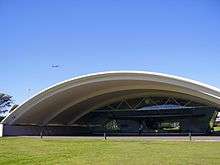
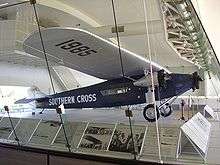
Shortly before Kingsford Smith's death in 1935, he sold the Southern Cross to the Commonwealth of Australia, for display in a museum.[13] The aircraft was brought out of retirement briefly in 1945 for the filming of the movie Smithy. The machine was refurbished in 1985 under the supervision of Jim Schofield, a senior aviation civil servant and air crash investigator. The Southern Cross is now preserved in a special glass hangar memorial on Airport Drive, near the international terminal at Brisbane Airport.
A full-sized flying reproduction of the Southern Cross was built in South Australia between 1980 and 1987, and is the largest known reproduction aircraft in the world.[14] Sergeant Anthony Lohrey of the Royal Australian Air Force, Aircraft Research and Development Unit (ARDU) oversaw its construction. On 25 May 2002 at Parafield South Australia she lost a main wheel on takeoff. The replica was landed on the one good wheel and the tail-skid with the pilot keeping the damaged undercarriage off the ground by keeping the wing high in the air. When the aircraft stopped the wing came down and snapped off ~3 m of the wing tip. After considerable negotiation the Historical Aircraft Restoration Society (HARS) acquired the aircraft from the SA Government in 2010, and the aircraft was transported to HARS facility at Illawarra Regional Airport, Albion Park, New South Wales. The replica aircraft is being restored to full airworthy status by HARS volunteers. This will include restoration of the handcrafted all-wooden spruce and plywood wing.[15] The aircraft carries the original registration of VH-USU.[16]
A personal tribute
Australian aviation enthusiast Austin Byrne was part of the large crowd at Sydney's Mascot Aerodrome in June 1928 to welcome the Southern Cross and its crew following their successful trans-Pacific flight. Witnessing this event inspired Byrne to make a 1:24 scale model of the Southern Cross, made mostly from brass finished in gold and silver plating. Kingsford Smith disappeared before Byrne had completed the model.
After Kingsford Smith's disappearance, Byrne continued to expand and enhance his tribute with paintings, photographs, documents, and art works he created, designed or commissioned. Between 1930 and his death in 1993, Byrne devoted his life to creating and touring his Southern Cross Memorial.[17]
Notes
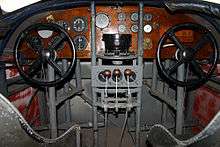
The Southern Cross's original registration was "1985" – this number can be seen on the wings and tail of the aircraft in photos taken at the time of its first record-breaking flight. Kingsford Smith re-registered it in Australia as "G-AUSU" (4 July 1928 to 3 July 1929), and then "VH-USU" (5 April 1931 – ).[13] The "1985" marks and original colour scheme were restored when the plane went on public display.
The Southern Cross was named after the Southern Cross constellation, a popular symbol of the Southern Hemisphere in general and Australia in particular. Kingsford Smith continued the theme with his later aircraft Southern Cross Minor and Southern Cross Junior (both Avro Avians), Miss Southern Cross (Percival Gull), and Lady Southern Cross (Lockheed Altair). He also produced a car with the name, and gave the aircraft operated by his airline, Australian National Airways, similar names beginning with Southern.
In September 2010, the Old Gateway Motorway, which runs past the site of the original Eagle Farm Airport, was renamed Southern Cross Way.[18]
References
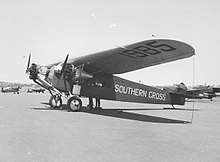
- ↑ Carl "Ben" Eielson, NAHF Archived 7 July 2007 at the Wayback Machine. (Pilot of the Detroiter)
- ↑ "Ace Pilots". Ace Pilots.
- 1 2 "Century of Flight". Century of Flight.
- ↑ ""Smithy" and the ''Southern Cross'', State Library of NSW". Atmitchell.com. Archived from the original on 18 September 2006.
- ↑ "30 May 2003 – 75th Anniversary of Smithy's Landing at Albert Park". Fiji.embassy.gov.au.
- ↑ Aviators – Charles Kingsford-Smith, includes photo of the plaque commemorating the flight across the Pacific and the landing at Brisbane on 9 June 1928
- ↑ Famous Fokker Flights Archived 11 October 2006 at the Wayback Machine.
- ↑ History of Eagle Farm (Our Brisbane)
- ↑ Photo of Southern Cross, and welcoming crowd, at Eagle Farm on 9 June 1928 (National Archives of Australia)
- ↑ "Magnificent Machines – Home-grown Legends". The Sydney Morning Herald. 16 December 2003.
- 1 2 3 4 5 6 Smith, Robert L. (1928). "The Fourth Propeller, A New Industry". San Francisco Business. XVII (11 July 1928). pp. 14–15, 35. Retrieved 17 January 2014.
- ↑ "First trans-Tasman flight touches down 11 September 1928". New Zealand History. NZ Government (Ministry for Culture and Heritage). 18 January 2017. Retrieved 23 February 2017.
The welcome in Christchurch was tremendous. About 30,000 people had made their way to Wigram, including many pupils from state schools, who were given the day off, and public servants, who were granted leave until 11 a.m.
- 1 2 "ADF Serials". ADF Serials. 10 January 2004.
- ↑ Southern Cross reproduction Archived 29 August 2014 at Archive.is
- ↑ "Fokker FVIIB "Southern Cross" Replica". HARS. 2014.
- ↑ "Famnous Australian Aircraft PTY Ltd F-VIIB/3M". Australian Government Civil Aviation Safety Authority.
- ↑ Austin Byrne Southern Cross Memorial collection highlight: National Museum of Australia
- ↑ "Gateway renamed the Southern Cross Way". The Sydney Morning Herald. 17 September 2010.
External links

- Old Newspaper Articles – various Australian newspaper reports and photos about the Pacific Ocean crossing in 1928
- Photos from an album kept by Charles Ulms' wife Mary, including many of the Southern Cross
- "The Fourth Propeller, A New Industry" (Photo & article on generator & radio sets used on Pacific flight.)